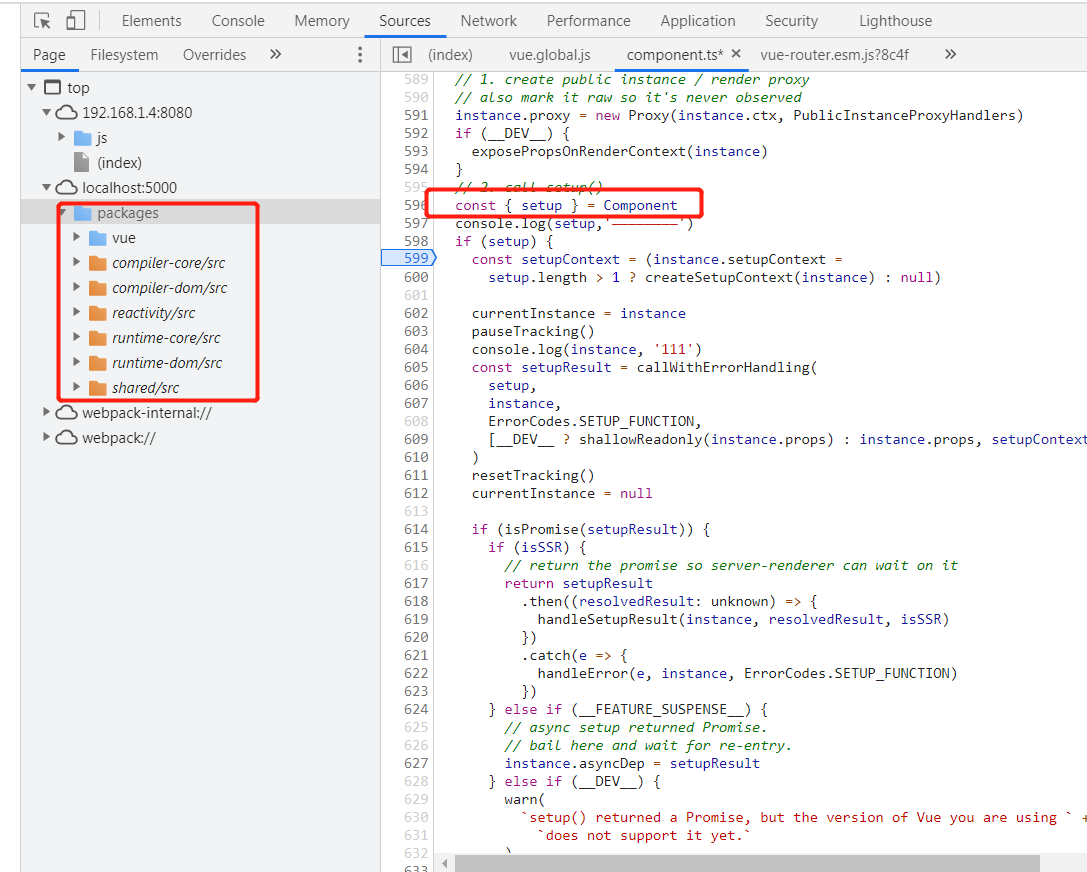Composition API 将是 Vue 3 的核心功能,它具有许多更改和性能改进。我们可以在 Vue 2 中通过 npm 插件@vue/composition-api 使用它。
本人重点将带你了解:
@vue/composition-api常见 api 使用- vue3 代码逻辑提取和复用
- 如何使用
provide+inject替代vuex方案
vue2 使用 composition-api
主文件 main.ts 或者 app.vue 添加
1
2
3
| import Vue from 'vue'
import VueCompositionAPI from '@vue/composition-api'
Vue.use(VueCompositionAPI)
|
Composition API 不再传入 data、mounted 等参数,
通过引入的 ref、onMounted等方法实现数据的双向绑定、生命周期函数的执行。
核心语法
reactive:接收一个普通对象然后返回该普通对象的响应式代理。
ref:接受一个参数值并返回一个响应式且可改变的 ref 对象。ref 对象拥有一个指向内部值的单一属性 .value。
computed:传入一个 getter 函数,返回一个默认不可手动修改的 ref 对象。
readonly:传入一个对象(响应式或普通)或 ref,返回一个原始对象的只读代理。一个只读的代理是“深层的”,对象内部任何嵌套的属性也都是只读的。
watchEffect:立即执行传入的一个函数,并响应式追踪其依赖,并在其依赖变更时重新运行该函数。可显式的调用返回值以停止侦听。
watch:全等效于 2.x this.\$watch (以及 watch 中相应的选项)。
setup 函数
现在要介绍的第一个 API 就是 setup 函数。
setup 函数是一个新的组件选项。作为在组件内使用 Composition API 的入口点。
先看个简单 demo
1
2
3
4
5
6
7
8
9
10
11
12
| <template>
<button @click="increase">count is: {{ count }}</button>
</template>
<script>
export default {
setup() {
let count = 0
const increase = () => count++
return { count, increase }
},
}
</script>
|
1、调用时机
创建组件实例,然后初始化 props ,紧接着就调用 setup 函数。
从 vue2 生命周期钩子的视角来看,它会在 beforeCreate 钩子之后,created 之前被调用。
2、模板中使用
如果 setup 返回一个对象,则对象的属性将会被合并到组件模板的渲染上下文。
3、渲染函数 / JSX 中使用
setup 也可以返回一个函数,函数中也能使用当前 setup 函数作用域中的响应式数据:
1
2
3
4
5
6
7
8
9
10
| import { h, ref, reactive } from '@vue/composition-api'
export default {
setup() {
const count = ref(0)
const object = reactive({ foo: 'bar' })
return () => h('div', [count.value, object.foo])
},
}
|
4、两个参数
props(注意 props 对象是响应式的),
context(上下文对象,从原来 2.x 中 this 选择性地暴露了一些 property。)
1
2
3
4
5
6
7
8
9
10
11
12
13
14
15
| const MyComponent = {
setup(props, context) {
let {
attrs,
emit,
isServer,
listeners,
parent,
refs,
root,
slots,
ssrContext,
} = context
},
}
|
ref & reactive
在 App.vue 中,点击事件绑定了 increase,然后修改了 count,
但是页面并没有发生改变,这是因为 setup 函数返回的对象中 count 不是响应式数据,
那么如何创建响应式数据呢?此时就要掌握响应式系统 API,我们可以使用 ref 和 reactive 创建。
1
2
3
4
5
6
7
8
9
10
11
12
13
14
15
16
17
18
19
20
| <template>
<button @click="increase">
count is: {{ count }}, state.count is {{ state.count }}
</button>
</template>
<script>
import { ref, reactive } from 'vue'
export default {
setup() {
let count = ref(0)
let state = reactive({ number: 0 })
const increase = () => {
count.value++
state.count++
}
return { count, state, increase }
},
}
</script>
|
接受一个参数值并返回一个响应式且可改变的 ref 对象。
ref 对象拥有一个指向内部值的单一属性 .value。
当 ref 作为渲染上下文的属性返回(即在 setup() 返回的对象中)并在模板中使用时,
它会自动解套,无需在模板内额外书写 .value
Vue 本身已经有 “ref“ 的概念了。
但只是为了在模板中获取 DOM 元素或组件实例 (“模板引用”)。
新的 ref 系统同时用于逻辑状态和模板引用。
reactive 接收一个普通对象然后返回该普通对象的响应式代理。
响应式转换是“深层的”:会影响对象内部所有嵌套的属性。基于 ES2015 的 Proxy 实现,返回的代理对象不等于原始对象。建议仅使用代理对象而避免依赖原始对象。
不要解构返回的代理对象,那样会使其失去响应性:
1
2
3
4
5
6
7
8
9
10
11
12
13
14
| <template>
<button @click="increase">count is: {{ count }}</button>
</template>
<script>
import { ref, reactive } from '@vue/composition-api'
export default {
setup() {
let state = reactive({ count: 0 })
const increase = () => state.count++
return { ...state, increase }
},
}
</script>
|
toRef 和 toRefs
那如果我们真的想展开 state 的属性,在模板使用 count 而不是 state.count 的写法那怎么办呢?我们可以使用 toRef 和 toRefs 这两个 API,进行转换成 ref 对象,之前已经介绍了 ref 对象是可以直接在模板中使用的。
toRef 可以用来为一个 reactive 对象的属性创建一个 ref。这个 ref 可以被传递并且能够保持响应性。
1
2
3
4
5
6
7
8
9
10
11
12
13
14
15
16
17
18
19
| <template>
<button @click="increase">
count is: {{ count }},count2 is: {{ count2 }}
</button>
</template>
<script>
import { ref, reactive, toRef, toRefs } from '@vue/composition-api'
export default {
setup() {
let state = reactive({ count: 0 })
let countRef = toRef(state, 'count')
let state2 = reactive({ count2: 0 })
const increase = () => state.count++
let stateAsRefs = toRefs(state2)
return { count: countRef, increase, ...stateAsRefs }
},
}
</script>
|
把一个响应式对象转换成普通对象,该普通对象的每个 property 都是一个 ref ,和响应式对象 property 一一对应。
computed & watch
1
2
3
4
5
6
7
| const countDouble = computed(() => count.value * 2)
watch(
() => state.count,
(count, prevCount) => {
}
)
|
代码逻辑提取和复用
Composition API 的第一个明显优势是很容易提取逻辑。解决了
逻辑提取
1
2
3
4
5
6
7
8
9
10
11
12
13
14
15
16
17
| export const useCount = (number) => {
const count = ref(0)
const increase = () => {
count.value += 1
}
const reset = () => {
count.value = 0
}
onMounted(() => {
count.value = number
})
return {
count,
increase,
reset,
}
}
|
代码复用
1
2
3
4
5
6
7
|
const { count, increase } = useCount(1)
console.log(count)
increase()
console.log(count)
reset()
console.log(count)
|
有效的解决了 mixins 复用命名冲突,难以识别命名来自哪个 mixin 文件的问题。
替代 vuex 状态管理
状态 store 可以放在一个单一的文件或者目录里,比如设置一个全局组件可以只用的配置 config
1
2
3
4
5
6
7
8
9
10
11
12
13
14
15
16
17
18
19
20
21
22
23
24
|
import { provide, inject, ref, onMounted, readonly } from '@vue/composition-api'
const configSymbol: symbol = Symbol()
export const useProvider = {
setup() {
let config = ref(null)
const configServer = async () => {
config.value = { name: '名字' }
}
onMounted(async () => {
await configServer()
})
provide(configSymbol, {
config: readonly(config),
})
},
}
export const useInject = () => {
return inject(configSymbol)
}
|
在最顶层的组件(例如 main.ts)上注入,config 就可以在所有的组件中使用
1
2
3
4
5
6
7
| import { defineComponent } from '@vue/composition-api'
import { useProvider } from './context/config'
export default defineComponent({
setup() {
useProvider()
},
})
|
业务逻辑页面使用 config
1
2
3
4
5
6
7
8
9
10
| import { useInject } from './context/config'
const Components = {
setup() {
const { config } = useInject()
console.log(config.value.name)
return {
config,
}
},
}
|
